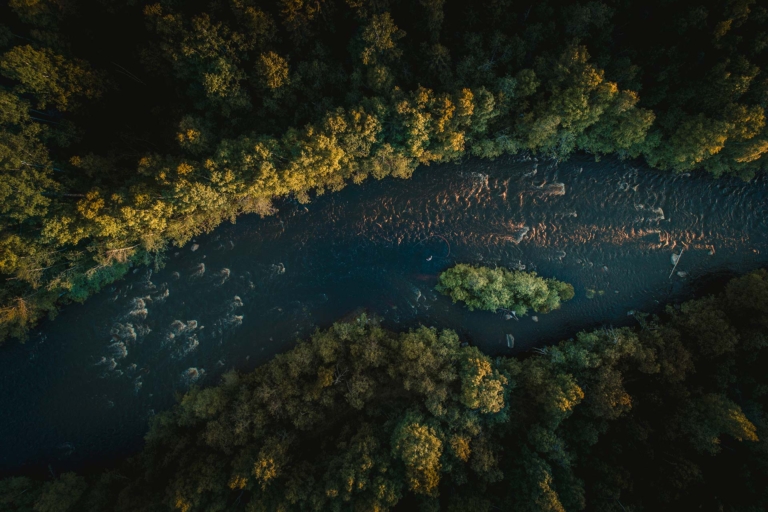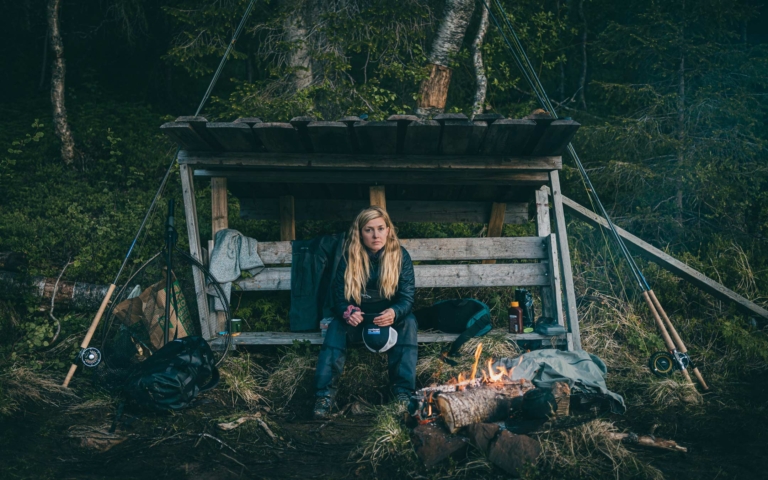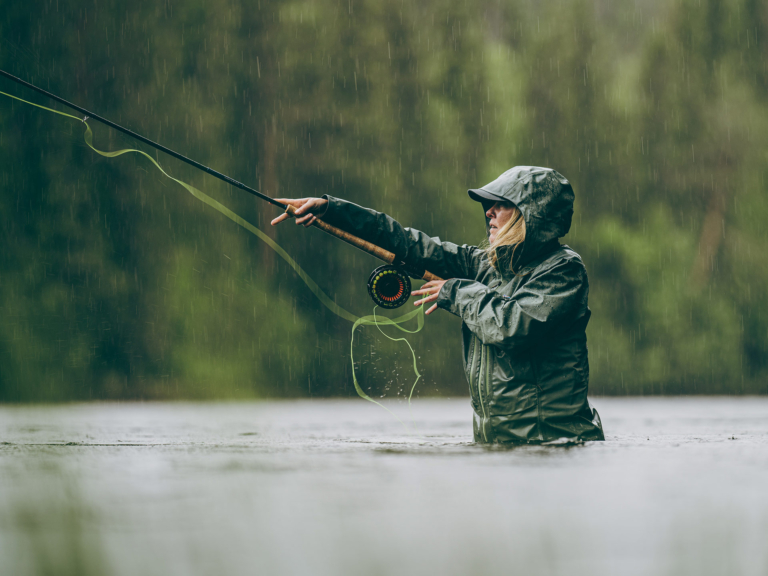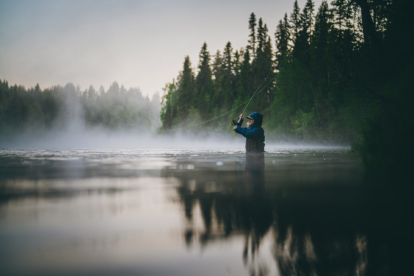Tight Lines Of Heart And Mind
Emilie Björkman on the rise and decline of wild Baltic salmon in Sweden’s remote northern rivers.
As soon as the fly passes the pointy rock and the line goes tight, I feel a tingle at my fingertips. First one. Then one more. My heart stops. I can’t breathe but my mind is racing. “Of course, that must have been a take.”
I remember what an old salmon bum told me a few years prior: “You need to give the fish time to return to his lay. Then you cast again. Wait at least five minutes.” Change the fly, too. The same pattern, just smaller.
But I can’t do any of that. I’m too wound up. I’m in the Sävarån, one of Sweden’s northern rivers, and have never been this close to netting a Baltic salmon before.
So, I do the opposite. After approximately 45 seconds I crash down into the river again, in the same place with the same fly. The cold water wraps around my body as I feel that unmistakable tug. A fresh bar of silver breaks through the water’s surface. It’s a cold rainy morning at the beginning of June, back in 2012 when I was 25 years old, and I get the overwhelming feeling that I’ll spend the remainder of my life chasing this sensation.
Fast-forward to 2024. Same place, same scenario, but with a very different result. The fly dances untaken across the river pool time and time again. Cast after cast. I can’t help thinking how different my life would have been if this was my sliding-doors moment, not that day in 2012. I reel in the line with a lump in my throat.

Photo: Ted Logart
Each year, wild Baltic salmon return to the rivers and streams that feed the Baltic Sea to spawn. An arm of the Atlantic Ocean, the Baltic is semi-enclosed by Sweden, Denmark, Estonia, Finland, Germany, Latvia, Lithuania, Poland, and Russia—but Sweden is home to some of the most reliable salmon rivers remaining. There were once more than 100 across the region. Now there are 16.
By the 1990s, Baltic salmon were in rapid decline. Some believed the species was on the verge of extinction, including Gustav Hellström, Associate Professor at the Swedish University of Agricultural Sciences and an expert on Baltic salmon. “The commercial fishing at sea was enormous. There were quotas, but they were so massive that the entire fleet didn’t come close to catching what they were allowed to. They still gave it their best shot,” explains Hellström. Add to this the rapid expansion of hydropower on most of the rivers, and things quickly went from bad to worse for wild fish populations.
Tougher fishing regulations were finally introduced in the mid 90s, but conservationists remained concerned. So much so that a gene bank was established to secure the DNA of the Baltic salmon species in the event of total population collapse.
I grew up in a small village in the middle of Sweden, in Dalarna. I wasn’t forced into fishing, but my parents loved it and brought us kids along. During winter we ice fished for perch and arctic char, and in summer we fished for roach and trout. Later in life my two sisters found a different path, but I stayed with fishing.

Photo: Ted Logart
I started to compete in ice fishing, and not long later I discovered fly fishing. It was love at first sight, but it also became my escape. My safe space when things got tough as a teenager. This path has led me into guiding, instruction, hosting several TV fishing series, and producing documentaries. In 2022, me and my cameraman, Ted Logart, set out to create a film of the Baltic salmon’s incredible comeback.
The big turning point came in 2011 when bans on large scale fishing were introduced in the Baltic. Ironically the bans weren’t to protect the salmon but the porpoise, a small dolphin-like cetacean which suffered from by catch. However, the impact on salmon was instant.
“The salmon returned to the rivers in a way we couldn’t have foreseen,” says Hellström. “It was an incredible sight. The Byskeälven river saw 7,000 fish through the counter, and the Torneälven was in a league of its own with more than 100,000 salmon running just three years after the introduction of the ban. It was amazing to watch nature recover with such force when mankind just gave it a chance.”
Those years following my first salmon were like a dream. I drove countless kilometres on remote dirt roads, spilled coffee in my lap, and—as we say in Sweden—felt like the midnight sun was forever in my eyes. I bought a fishing licence where my intuition told me to, slept in the car when I got tired, and cooked sausages over an open fire when I got hungry. Our lines were always tight, and in some sense there wasn’t a cloud on my horizon.
The north of Sweden has a young history when it comes to fly fishing for salmon. In the old days, salmon was a necessity for survival, and the fishing belonged to the people—the farmers and the Sámis, the indigenous people of the Nordic countries. It wasn’t until the 1970s that the first fly rods were seen on the salmon rivers, and ever since then salmon fishing in the north of Sweden has been characterised by open access. Private and exclusive beats are still a rare sight.
All this has created a culture of freedom along the rivers—a culture I love. For me, fly fishing isn’t a social event. I want to be by myself or in the company of a few fellow fishers who share the same attitude. To be out there fishing, 24/7, on a diet of sausage, embracing sore shoulders and a stiff back from too many sloppy casts.

Photo: Ted Logart
The revival story of the Baltic salmon was one of total success. The slumbering river valleys had awakened. Fly fishing tourists started to travel here in bigger numbers, and with them came an injection of new money into the rural areas up north. Yes, the runs varied from year to year, but the trend was steady and positive. Then came the season of 2023.
“From an average run of 65,000 fish a year we saw a drop to 20,000 salmon in Torneälven,” says Lars Munk, a salmon fly fisher and guide in Swedish Lapland. “And the following year was the same.”
Why this is happening isn’t an easy question to answer. Commercial fishing for salmon is at historically low levels. More and more rivers are being restored, providing an ever-growing area of spawning grounds and favourable habitats. But still the runs are declining drastically.
In recent years, a new industrial player has burst onto the scene: trawlers. Known as pelagic fodder fishing, huge vessels scour the sea to catch fish for use as animal feed. There’s a near-endless demand for fodder from the salmon farming industry, and the main species these trawlers catch are herring and sprat—large sources of prey for Baltic salmon.

Photo: Ted Logart
We also know that climate change is impacting the Earth’s poles drastically, and with that comes warmer water temperatures which salmon are incredibly sensitive to. Today it’s not uncommon for rivers to reach 18 degrees celsius or more in the beginning of June.
The reason for the recent drop in numbers is clearly complex. Even with the help of scientists, it’s hard to find a definitive cause for their decline. But that shouldn’t stop us doing what we can to help the salmon.
In the public realm, we must convince those with political power to turn things around—establishing greater protections for the rivers and ecosystems the salmon depend on, and tougher regulations for the industries that are threatening their survival. We can also take our own small but powerful actions individually, like avoiding products from the open net salmon farming industry, and only eating fish that’s caught responsibly. And as a community, we can promote responsible fishing practices such as catch and release.
In the end, I am just a fly fisher who deeply depends on healthy runs in the river for my wellbeing. I’ll keep doing everything I can to protect wild Baltic salmon, because I can’t help thinking, who would I be without them?

